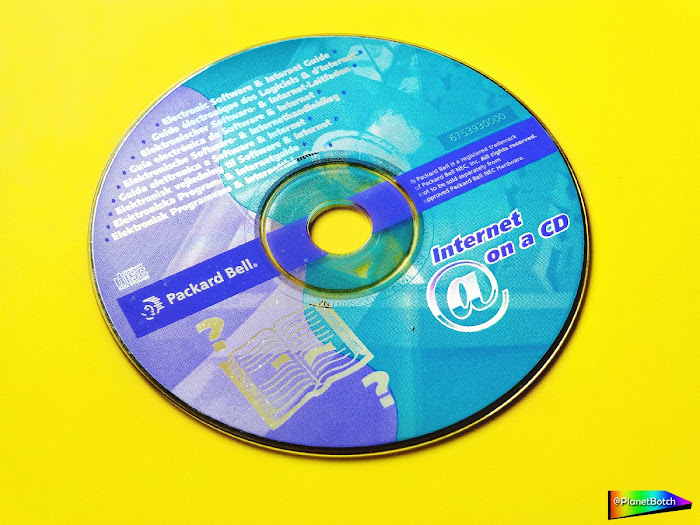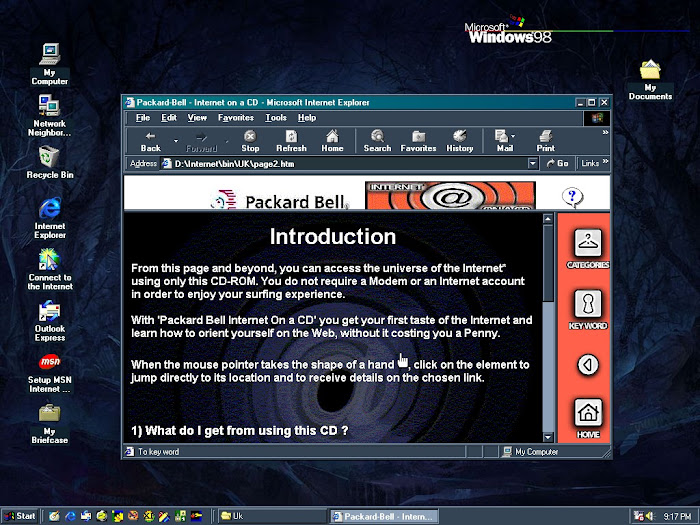CD-ROMs can't be edited, and when it comes to looking back into history, that is their most commendable property...

If you’ve ever wondered why there was such an explosion in Internet use forward from the Christmas of 1998, the artefact I’m talking about is this post serves as a perfect illustration. It’s called Internet on a CD, and it was the home PC vendor Packard Bell’s bid to turn each computer sale into a recurring revenue stream.
Internet on a CD was given away to purchasers of new Packard Bell PCs in the run up to Christmas 1998. I got mine with a Club 30 model. The concept of the CD was to collect a representative cross section of websites, put their pages onto local media, and reassign their internal links so that clicking them served the new page from the CD rather than from the Web. Essentially just give consumers the feel of using the Internet. Get them hooked. Add to that a front end comprising Packard Bell’s own introductory and tutorial material, and you had something along the lines of…
“This is the Internet, here’s how you use it, and if you slip us a few quid we can get you signed up…”
CDs were heavily utilised in pushing the Internet to PC consumers around the cusp of the millennium, but this was a much more organised and clever approach than was typical.

Obviously, in 1998 this was about sales, and only sales. Companies like PB could smell recurring revenue, and that’s always been the sweetest aroma in business. But with the passage of time, the CD has become a brilliantly pure historical document which, importantly, remains accessible via 1990s browsers. You get a totally uncontaminated vision of the 1990s Internet, with no possiblity of any subsequent interference.
That’s not just important for anyone studying the culture of the time, or the trends in web page design circa 1998. It’s also fascinating for techies studying how the pages were formed in those days.
The use of HTML has changed very considerably in the interim, and via this CD you get to see all the old protocols. Very heavy dependency on table structures, and the tags are often capitalised, so 'href' and 'p' are typed 'HREF' and 'P'. Some of the keyword stuffing in the meta descriptions rivals the actual acticles for wordcount… Well, almost. And you see lots of obsolete (and always controversial) HTML styling attributes like BGCOLOR. When the featured sites were developed, HTML was still in its infancy, and the ‘standard’ HTML4 was brand new.
But it worked, and the sites on the CD reproduce well not only in the native Windows 98 Internet Explorer, but in current browsers too. Today there are people spending about three days writing and testing JavaScript functions to reliably accomplish things that a simple 1998 HTML table structure could achieve in five minutes. And the old HTML table loaded the page vastly more quickly too.
Although the cutoff for the site roundup was mid 1998, some of the sites represent the state of play as it was in 1997 or 1996 – or even earlier. So you see plenty of pre-HTML4 webmastery. At the other end of the scale, Bjork’s WebSense was up to the minute and written with Microsoft Frontpage 3. Heavily reliant on Frames, the page code carries the error message:
“This page uses frames, but your browser doesn't support them.”
Some of the other sites look like they were written using Netscape Navigator Gold’s HTML editor, which even today is great for writing and formatting basic blog posts offline.
Obviously, you can still find some of the websites on Wayback Machine today, but you get errors such as missing images, and the biggest problem of all – the fact you can no longer use Wayback Machine with an original late 1990s browser. Internet on a CD enables you to view the sites with the browsers people were using in the late 1990s. The CD also shows you the original ad banners from networks like the Banner Network and LinkExchange, although the links to ad networks are cut dead and the CD just says it can’t show the page.
One of the most universally interesting aspects of the CD is the range of sites it chose to represent the Internet. While you might have expected a huge corporation to offer up a selection of boringly professional sites, that's not what it did at all. The selection is very diverse, taking a trip through hardcore Star Wars fandom, early photo publishing, irreverent humour, musician and pop star sites, tech coverage of HTML… PB cast a wide net. Indeed, some of the more weird and wack inclusions were quite brave, even including some swearing. One wonders how thoroughly the Packard Bell compilation bods were checking the sites.
But part of the intention, I suspect, was not just to show consumers that there was plenty of entertaining stuff to read or look at on this newfangled Internet thingy, but to show them that creating a web presence was something literally anyone could do. You didn't have to be a star, a media group or a commercial organisation to reach an audience of thousands. By including personal sites that were clearly set up by ordinary individuals, the CD appealed to people's egos. It didn't say so per se, but the subtext was…
"This could be you".
Internet on a CD not only reveals how the collective of tech businesses “sold” the World Wide Web to consumers – it also encapsulates the experience of web-surfing circa 1998 better than anything remaining on the real Internet can. Wayback Machine is a fantastic resource for revisiting the past. But its accuracy of preservation cannot rival a meticulous period compilation which has remained in a completely static environment for over two decades.
The CD does still come up for sale for throwaway prices, and even if you don't want to dissect the HTML, I'd say it's great value as a window into a long lost internet. Very entertaining at times too.